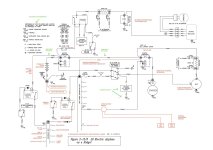YankeeBravo
Member
Good day,
Attached is my modified Z-13 diagram, my knowledge of electrics being quite weak, I would really appreciate any inputs, correction and review of my modification.
RV-10 Z-13 architecture with a single battery, 2 alternators. 2 good old magnetos, no EI. Electrical and avionic redundancy to aim for IFR authorization/operation (quite uncommon and difficult here in Europe). Philosophy is to keep it as simple as possible and goal is to have a failure of the main alternator, main bus, battery contactor covered and to keep for an extended period of time only the necessary instruments to fly the right way up, navigate and shoot an ILS through an independent essential bus.
One question (in green) is about wire size with aft battery, the remark is misleading. Shall I go back to 2AWG ISO 4AWG for the wires in and out of the battery contactor ?
Is the Crowbar OVM module and grounding in the DC Power Master switch necessary (the plane power main alternator has already an overvoltage protection but not sure there is a link between the 2 ?
In general, where should the S704-1 relay be positioned in relation to the switch (doesn’t matter, within 6 inches…)
Thanks in advance and enjoy your day !
Attached is my modified Z-13 diagram, my knowledge of electrics being quite weak, I would really appreciate any inputs, correction and review of my modification.
RV-10 Z-13 architecture with a single battery, 2 alternators. 2 good old magnetos, no EI. Electrical and avionic redundancy to aim for IFR authorization/operation (quite uncommon and difficult here in Europe). Philosophy is to keep it as simple as possible and goal is to have a failure of the main alternator, main bus, battery contactor covered and to keep for an extended period of time only the necessary instruments to fly the right way up, navigate and shoot an ILS through an independent essential bus.
One question (in green) is about wire size with aft battery, the remark is misleading. Shall I go back to 2AWG ISO 4AWG for the wires in and out of the battery contactor ?
Is the Crowbar OVM module and grounding in the DC Power Master switch necessary (the plane power main alternator has already an overvoltage protection but not sure there is a link between the 2 ?
In general, where should the S704-1 relay be positioned in relation to the switch (doesn’t matter, within 6 inches…)
Thanks in advance and enjoy your day !
Attachments
Last edited:





